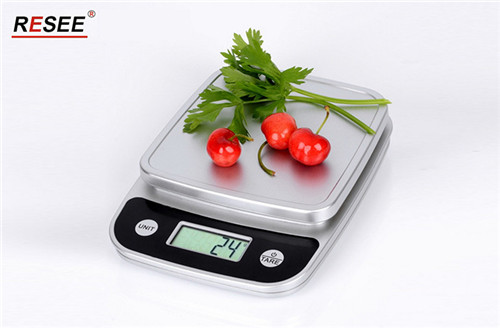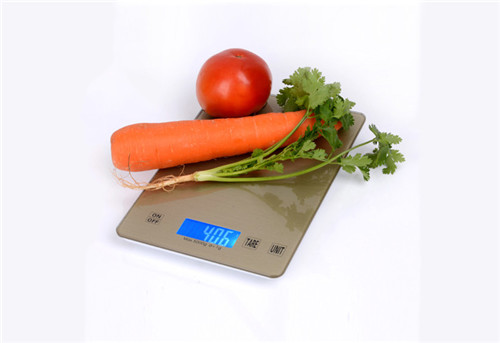How to use the family kitchen scale?
How to use the kitchen electronic scale, it suddenly found that most people do not understand the difference between the amount of uncooked food and the amount of cooked food. Learn how to adjust yourkitchen scale to help you identify the right amount of food you eat and help you reduce calories and weight naturally. Adjusting the size of the food part is a simple process that can help you lose weight. A convenient way to control portion sizes by weighing food on kitchen scale before eating can be easily accomplished at home using a basic kitchen scale.
Step 1
Determine the type of kitchen scale you want to use. Some people prefer digital scales because they provide accurate measurements without guessing; others include spring-type kitchen scales. When choosing, focus on scales with numbers you can easily read, and within your budget, have a bowl or cup for storing food and for easy use.
Purchase kitchen scale. It is better to choose digital scale with counting function. The kitchen scale is often cheaper, but the digital scale is more accurate and reliable. Accurate measurement is needed when measuring weight.
Second steps
Read the manual manual attached to your kitchen scale, first of all, know how to adjust the kitchen scale. The manual may not have a simple tutorial, but some digital scales have advanced functions such as calorimetry and nutritional value. Reading instructions will help you understand the specific functions of kitchen scales. Open the kitchen scale and adjust your kitchen scale to zero. Depending on the type of kitchen scale you buy, this may be as simple as turning on the scale and waiting until the display "0". For spring and kitchen scales, you may need to turn the knob on scale to Place the kitchen scale on a flat surface, such as a kitchen table or a kitchen counter. You need plenty of space to put scales and prepare food for weighing. 0.
Weigh bowls or containers for your weighing food. You need to know the weight of the container so that you can subtract it from the number in the scale when you add food to it. The answer will provide you with the actual weight of the food. Some scales attached to the container have a special button that automatically records the container; use this function as specified by the manufacturer.

Third steps
Put the food part in the container on the kitchen scale. Please wait a minute before reading the weight. If you are using digital scale, you will see the weight automatically displayed, or you may need to set it to indicate the type of food you weigh in the scale. Follow the manufacturer's instructions to get the correct readings.
Fourth steps
Calibration ratio. Place a clean plate or bowl firmly in the center of the scale so that it does not shake or shake. Press the count button and, if necessary, subtract the weight of the container from the reading so that the final weight can be calculated better when weighing the food.
Fifth steps
Remove the board from the kitchen scale and place it safely on the worktable. Now, the scale should give the negative reading of the weight of the plate.
Sixth steps
The kitchen calls out the required size. The standard portion of most meat and fish is 3 ounces. Find the weight information on the package and weigh it before washing or cooking it. Put the food tray on the scale. The calibrated scale can only measure the weight of the food. Before reaching the required parts, remove or add more food. If you do not press the count button again, you can remove the printing plate several times. For hygiene reasons, you need to thoroughly wash dishes with hot water and detergent between weighing different foods.

PS: trim any visible fat in meat products. An ounce of intensive breakfast cereal and 200 milliliters of skimmed milk make a nutritious, low calorie breakfast. Experts offer different opinions on when you weigh food. One rule of thumb is that you weigh meat after cooking, but you should weigh grains, fresh fruits, vegetables and other foods that are inflated after cooking. Another option is to weigh the food before and after cooking, so you can see the contrast between the two different weights.
One of the most important things you can do when you try to control the calories of the food you are eating is to pay attention to weight. Although taking out the kitchen scale and measuring the weight of food may be the most accurate way to calculate the amount of food, it is not always feasible or practical. If you don't have kitchen scale or you don't want to use a scale, there are other ways to estimate the food portion, such as comparing the size of the food to a regular household item. You can also buy special containers to eliminate part of the control speculation, separate storage and weighing of raw cooked food to prevent cross contamination.

Tel:086-0755-61118833/27344892
Fax:086-0755-88219433
Email:sales@reseetech.com
URL:www.reseetech.com.cn、www.reseetech.com
Address:Room 1102,Building 22, Shapu Wai Community Entrepreneurship Industrial Zone, Songgang Street, Baoan District, Shenzhen City, CHINA
